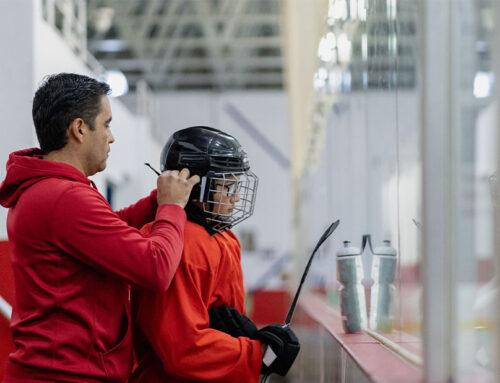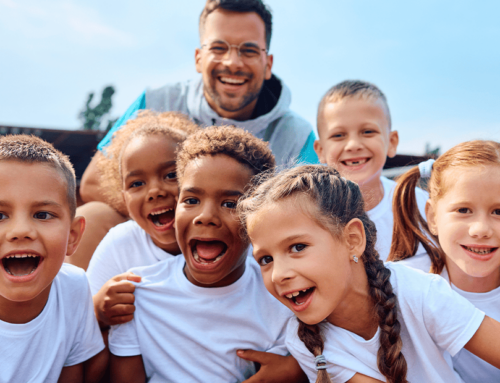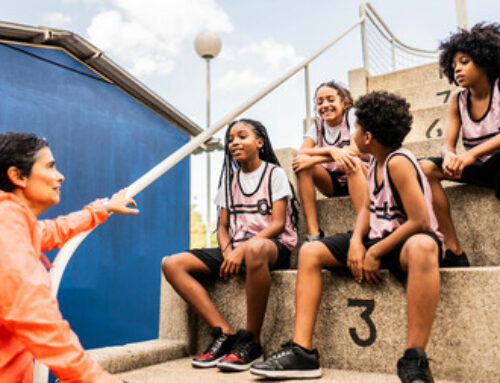Bodyweight Exercises For Kids
Parents often ask me when their child can lift weights. How much and how frequent are also questions I get a lot. The answer isn’t black and white, as with everything related to the human body. Weight training is a highly complex topic. Asking for ideas on a prepubescent athlete is way more complex.
When parents ask about weight training, there’s usually some reservation about safety. Will weight training stunt my child’s growth? Will it damage their joints? There’s a lot of speculation. No doubt there are safety concerns with all exercises. Still, we also know many benefits to be strong, particularly for athletics.
So, is weightlifting safe for kids? The answer is an absolute yes. BUT, there’s a catch. For any athlete, kid, or adult, the right to lift weights must be earned. Kids should exercise and lift weights, but only if they can use proper techniques. Proper technique requires a certain amount of strength and motor control. A solid and coordinated foundation must be established before adding additional resistances. Having a child lift weights before mastering their bodyweight is like shooting a cannon off of a canoe. The body and canoe will fall apart without a proper foundation.
Should kids lift weights? Yes, but bodyweight first.
Why Should Kids Strength Train?
A healthy kid is a highly physical and curious kid. They run to everything; they wrestle, jump off the couch, climb trees, play tag, roll in the dirt, throw balls at windows, and hit mom and dad with a stick. They are masters of chaos. With all that running, jumping, and general changes of direction comes a certain amount of strength demands. Running causes the landing leg to land with anywhere from 3-7 times your bodyweight. Kids certainly don’t run and jump with excellent efficiency, so it’s easy to imagine that kids regularly have to absorb forces ten or more times greater than their body weight. And they do it for fun!
I completely understand a parent’s reservations about weight training. But hopefully, putting it in this way, they will realize their child has been lifting relatively heavy weights ever since they could walk. And no, weight training will not damage growth plates. https://thebarbellphysio.com/weightlifting-for-children/ https://pubmed.ncbi.nlm.nih.gov/24393806/
There are four basic human movements that kids should focus on to develop a healthy, well-rounded strength program:
- push
- pull
- squat
- hinge
Push
Pushing is obvious. There is horizontal and vertical pushing. This movement is the most intuitive one for kids. At just a few months old, a baby pushes up to lift its head to gaze upon the world. This allows them to progress to other milestones such as crawling and pushing up to stand.
For kids and adults alike, you can never outgrow pushups. Kids can safely and effectively learn to do proper pushups and progress their efficiency. Can’t do a pushup? Try holding the arms straight in a pushup position. This will build pushing strength and endurance while not requiring the strength to lift your entire bodyweight.
Pull
Pulling is a little less obvious but just as intuitive for children. With limited mobility, we learn to grab and pull things to us at a very early age. Like pushing, we can pull vertically or horizontally, one or two arms at a time.
It can be harder to build strength pulling your own bodyweight without equipment. Perhaps the best, most functional, and fun way is to climb. Learn to climb a (short) tree. If you have access to one, a chin-up bar can be a valuable tool. And if you have a chin-up bar, you could get suspension straps such as TRX straps. This will allow you to do TRX rows.
Squat
You may have heard it said that you’d never see a better squat than from a baby.
Perfectly aligned spine, great hip mobility, all with good motor control. Bodyweight squats with the perfect baby-like technique are a great exercise for kids.
But we don’t hop on two legs like kangaroos, do we? We run, climb, and change direction one leg at a time. So it makes sense that we need to be strong, one leg at a time. Nothing accomplishes this better than a lunge. Forward, side, and reverse lunges should all be part of a strength training program. Remember, kids land with up to 10 times their bodyweight on the ground. Solid and stable legs are a must. Lunges are a powerful method to develop that strength.
Hinge
The most confusing one of all. Hinging may look like a squat, but they aren’t. Think of squatting as a vertical, knee-dominant movement. Hip hinges, instead, are a hip dominant, horizontal movement. Practice the hip hinge first. These aren’t muscularly strenuous but a must if you want to progress to more difficult exercises.
Learning to hip hinge is more movement practice than exercise. Once that is mastered, kids should move on to what I think is one of the best exercises in existence: the single-leg RDL.
The single-leg RDL is a fantastic bodyweight exercise that improves hip mobility, strength, and total body balance. All of this is essential for the healthy development of young kids and even adults.
How Much and How Often?
That’s a good exercise base for starting a strength program for kids. No equipment is necessary. These exercises can be done in a living room or outside for free. No gym membership is needed. They are all perfectly safe, especially given the fact they already do these movements in play.
RECOMMENDED FOR YOU
Bodyweight Exercises For Kids
Parents often ask me when their child can lift weights. How much and how frequent are also questions I get a lot. The answer isn’t black and white, as with everything related to the human body. Weight training is a highly complex topic. Asking for ideas on a prepubescent athlete is way more complex.
When parents ask about weight training, there’s usually some reservation about safety. Will weight training stunt my child’s growth? Will it damage their joints? There’s a lot of speculation. No doubt there are safety concerns with all exercises. Still, we also know many benefits to be strong, particularly for athletics.
So, is weightlifting safe for kids? The answer is an absolute yes. BUT, there’s a catch. For any athlete, kid, or adult, the right to lift weights must be earned. Kids should exercise and lift weights, but only if they can use proper techniques. Proper technique requires a certain amount of strength and motor control. A solid and coordinated foundation must be established before adding additional resistances. Having a child lift weights before mastering their bodyweight is like shooting a cannon off of a canoe. The body and canoe will fall apart without a proper foundation.
Should kids lift weights? Yes, but bodyweight first.
Why Should Kids Strength Train?
A healthy kid is a highly physical and curious kid. They run to everything; they wrestle, jump off the couch, climb trees, play tag, roll in the dirt, throw balls at windows, and hit mom and dad with a stick. They are masters of chaos. With all that running, jumping, and general changes of direction comes a certain amount of strength demands. Running causes the landing leg to land with anywhere from 3-7 times your bodyweight. Kids certainly don’t run and jump with excellent efficiency, so it’s easy to imagine that kids regularly have to absorb forces ten or more times greater than their body weight. And they do it for fun!
I completely understand a parent’s reservations about weight training. But hopefully, putting it in this way, they will realize their child has been lifting relatively heavy weights ever since they could walk. And no, weight training will not damage growth plates. https://thebarbellphysio.com/weightlifting-for-children/ https://pubmed.ncbi.nlm.nih.gov/24393806/
There are four basic human movements that kids should focus on to develop a healthy, well-rounded strength program:
- push
- pull
- squat
- hinge
Push
Pushing is obvious. There is horizontal and vertical pushing. This movement is the most intuitive one for kids. At just a few months old, a baby pushes up to lift its head to gaze upon the world. This allows them to progress to other milestones such as crawling and pushing up to stand.
For kids and adults alike, you can never outgrow pushups. Kids can safely and effectively learn to do proper pushups and progress their efficiency. Can’t do a pushup? Try holding the arms straight in a pushup position. This will build pushing strength and endurance while not requiring the strength to lift your entire bodyweight.
Pull
Pulling is a little less obvious but just as intuitive for children. With limited mobility, we learn to grab and pull things to us at a very early age. Like pushing, we can pull vertically or horizontally, one or two arms at a time.
It can be harder to build strength pulling your own bodyweight without equipment. Perhaps the best, most functional, and fun way is to climb. Learn to climb a (short) tree. If you have access to one, a chin-up bar can be a valuable tool. And if you have a chin-up bar, you could get suspension straps such as TRX straps. This will allow you to do TRX rows.
Squat
You may have heard it said that you’d never see a better squat than from a baby.
Perfectly aligned spine, great hip mobility, all with good motor control. Bodyweight squats with the perfect baby-like technique are a great exercise for kids.
But we don’t hop on two legs like kangaroos, do we? We run, climb, and change direction one leg at a time. So it makes sense that we need to be strong, one leg at a time. Nothing accomplishes this better than a lunge. Forward, side, and reverse lunges should all be part of a strength training program. Remember, kids land with up to 10 times their bodyweight on the ground. Solid and stable legs are a must. Lunges are a powerful method to develop that strength.
Hinge
The most confusing one of all. Hinging may look like a squat, but they aren’t. Think of squatting as a vertical, knee-dominant movement. Hip hinges, instead, are a hip dominant, horizontal movement. Practice the hip hinge first. These aren’t muscularly strenuous but a must if you want to progress to more difficult exercises.
Learning to hip hinge is more movement practice than exercise. Once that is mastered, kids should move on to what I think is one of the best exercises in existence: the single-leg RDL.
The single-leg RDL is a fantastic bodyweight exercise that improves hip mobility, strength, and total body balance. All of this is essential for the healthy development of young kids and even adults.
How Much and How Often?
That’s a good exercise base for starting a strength program for kids. No equipment is necessary. These exercises can be done in a living room or outside for free. No gym membership is needed. They are all perfectly safe, especially given the fact they already do these movements in play.










